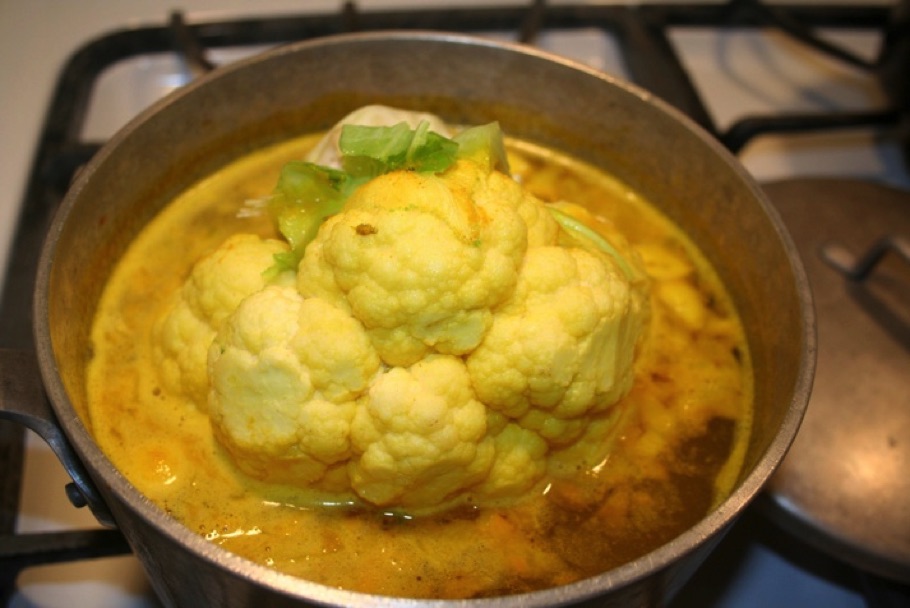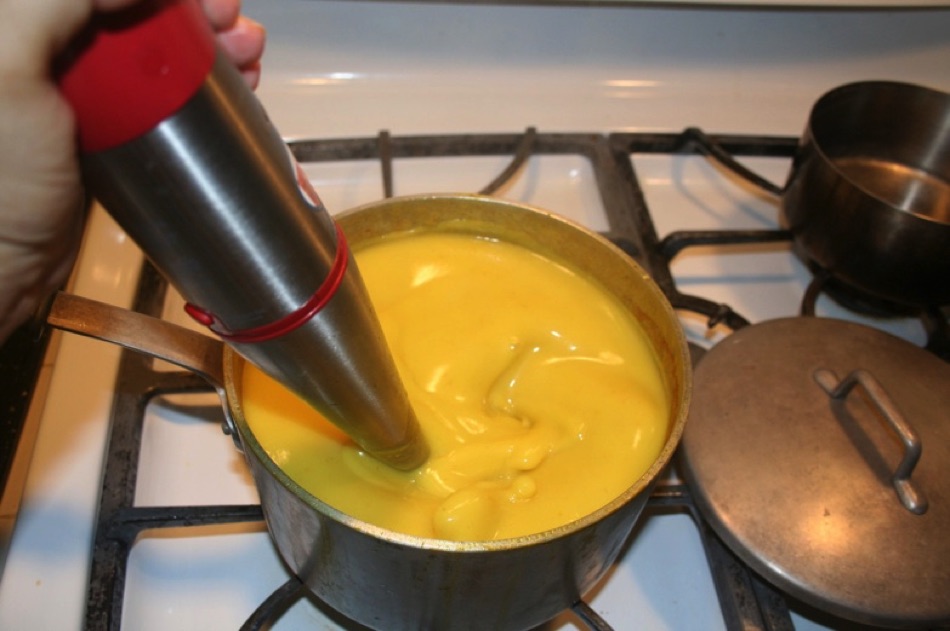EVERYTHING YOU EVER WANTED TO KNOW ABOUT TURMERIC
BUT WERE AFRAID TO ASK
By
Chef Henry M. Summers

dried ground turmeric and whole rhizomes
Imagine an ape-like ancestor of modern humans foraging through the the primeval leaf litter for something to snack on. With a stick modified into a primitive digging tool, he uproots a rhizome (fleshy underground stem) of Curcumin aromatica–wild turmeric.
A brutish hand wipes away some antediluvian soil. Suspiciously, he sniffs the mysterious object.
Torn between distrust and curiosity, he takes a tentative nibble. Scratching his protuberant supraorbital torus, he utters inchoately "I be monkey's uncle! This taste like curry powder!"
Curcumin longa, wild turmeric's domestic descendent, has been cultivated in South Asia since the earliest days of agriculture. It is responsible for turmeric's bright yellow-orange color and much of the characteristic taste of commercial curry powder, of which it is the most prominent ingredient.
Turmeric's colorfastness as a textile dye may have been discovered when a Neanderthal got a spot on the very first white shirt (purchased, perhaps, from the cavemen's department at Bam-Bam-berger's?) and not even his dry cleaner could get it out. (The necktie, of course, would have to wait until later, and the invention of the neck.)
Through eons of observation, it was discovered that in addition to being both a valuable dye and seasoning, turmeric was big medicine. Curcumin, the polyphenol responsible for turmeric's taste, color and smell, is showing promise in scientific trials as a treatment for a wide range of illnesses, including Alzheimer's disease and pancreatic cancer.
Turmeric has been used successfully as an antiseptic, anti-inflammatory agent, and antibiotic. It is even anti-ant–nobody knows why, but if you sprinkle a line of it on your threshold, the creepy little buggers are loathe to cross it.
The absorption of curcumin is enhanced 2,000-percent when ingested at the same time as piperine, an alkaloid found in black and white pepper (Piper nigrum). Curcumin and piperine are available in pill form for preposterous prices. But I guarantee that you will find my curried cauliflower bisque far easier to swallow.

curried cauliflower bisque
What makes a bisque a bisque, and not a crème or velouté? Bisques are soups based on purées of one thing and another–often the flesh and shells of shrimps and lobsters, and in former times, pigeons. But instead of roux, bisques are thickened with rice.
Classically, aromatic vegetables (along with the shells if shrimp, lobster or crab are used) are cooked in butter, then flamed in cognac. Next, the eponymous ingredient is added, and moistened with an appropriate quantity of stock. After prolonged simmering, everything is puréed till smooth enough to pass through a horsehair sieve. Finally, the purée is diluted with an obscene amount of cream, and finished with a glass of old sherry or Madeira.
If nobody told you otherwise, you might well find that my curried cauliflower bisque tastes just as over-the-top as the classic. Whether you inform your guests or family that it's virtually fat free, very low in calories, and full of fiber and antioxidants–well, I'm sure it's no business of mine.
Cauliflower is available in supermarkets the year 'round, but the local harvest begins in late August, then continues into late autumn. Nutritionally, it packs the same heavyweight punch as its cruciferous cousins, broccoli and cabbage.
Look for heads that are heavy for their size, with a minimum of surface discoloration on the florets, which together constitute the curd.
Ingredients
Cauliflower, 1 whole
Rice, raw, 1/4 cup
Onion, medium, cut into eighths
Garlic, 3 or 4 cloves, crushed
Ginger, fresh, slice the size of a quarter
Carrot, medium, quartered (optional)
Mustard seed, whole white, 1 teaspoon
Cumin seed, whole, 1 tablespoon
Turmeric, ground, 1 tablespoon
Peppercorns, whole, black or white, 1 teaspoon
Clove, whole, 1
Buttermilk, 1-1/2% or 2% fat, 1 quart
Peppers, hot, red or green, to taste (optional)
Salt, to taste (optional)
Trim any tough or blemished leaves from the cauliflower, and the hardened end of the stump. With a knife or swivel peeler, remove any black or brown discoloration from the surface of the curd. Immerse the trimmed cauliflower in a bowl of cold, salted water–this will bring any insect interlopers out of hiding.
While the cauliflower is soaking, place a five- or six-quart soup pot over a low flame. Add the mustard seeds, peppercorns and clove to the dry pan, and shake the pan for a few minutes until the spices are fragrant. Off the flame, add the turmeric.
Quarter the cauliflower and place it in the pot with the spices. Add the onion. garlic, ginger, carrot, and optional hot peppers. Cover level with cold water. Bring the pot to a boil over high heat, reduce to medium, cover loosely, and cooked until a knife inserted into the core of the cauliflower encounters no resistance.
Off the flame, add the buttermilk, and using an immersion blender, reduce everything to a smooth purée. If desired, add salt to taste. Reheat to serve. Offer quartered limes, sliced pickled jalapeños, chopped cilantro, and a dollop of fat-free Greek yogurt. In warm weather, curried cauliflower bisque is delicious chilled.


the discovery of turmeric